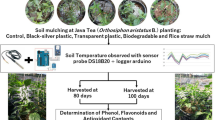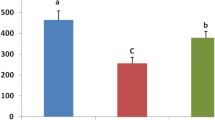Abstract
The effects of organic (OFS) and conventional (CFS) farming systems on soil nitrogen and tea (Camellia sinensis L.) leaf physiological as well as biochemical properties under humid sub-tropical conditions were studied at the experimental field of Tocklai Tea Research Institute, Jorhat, Assam, India. A part of the field under CFS was converted to organic in 2008 by using different organic manures, viz., vermicompost, P-enriched vermicompost, de-oiled neem cake, and inserting green crop, besides phosphorous (P) and potassium (K) solubilizing bacteria. After 4 years of conversion process, OFS resulted in significantly higher values for leaf total catechin (262.03 mg g−1), (−)-epigallocatechin gallate (EGCG, 159.97 mg g−1), and (−)-epicatechin gallate (ECG, 42.93 mg g−1) contents although there was up to 22 % reduction in tea yield. On the other hand, CFS resulted in significantly higher values for soil available nitrogen (154 mg kg−1) contents as well as for leaf chlorophyll a (2.51 mg kg−1), chlorophyll b (1.02 mg kg−1), and total chlorophyll (3.53 mg kg−1), contents. No significant difference was observed for caffeine, (−)-epigallocatechin (EGC), (+)-catechin (C), and (−)-epicatechin (EC) contents between the two farming systems studied. Correlation analysis indicated that (−)-EGCG was the major catechin fraction significantly correlated with leaf chlorophyll a, chlorophyll b, and total chlorophyll contents. The present study has provided knowledge on soil available nitrogen as well as leaf physiological and biochemical contents in tea shoots under humid sub-tropical conditions in Northeast India.


Similar content being viewed by others
References
Arnon DI (1949) Copper enzymes in isolated chloroplasts, polyphenol oxidase in Beta vulgaris. Plant Physiol 24:1–15
Ashihara H, Sano H, Crozier A (2008) Review. Caffeine & related purine alkaloids: biosynthesis, catabolism, function and genetic engineering. Phytochemistry 69:841–856
Avery A (2007) Going organic. Crop Soil 40:8–12, Amer. Soc Agron. Madison, WI. USA
Barthakur BK (2011) Recent approach to Tocklai to plant protection in tea in North east India. Sci Cult 77(9–10):381–384
Bhagat RM, Phukan IK, Das S, Debnath S, Sharma A (2011) Effect of value added manures on soil quality and yield of organic tea in North East India. Proceedings of Tea. Organic. Low Carbon International Symposium, Guangyuan, pp 98–108
Bojović B, Marković A (2009) Correlation between nitrogen and chlorophyll content in wheat (Triticum aestivum L.). Kragujevac J Sci 31:69–74
Bryant JP, Chapin FS III, Klein DR (1983) Carbon/nutrient balance of boreal plants in relation to vertebrate herbivory. Oikos 40:357–368
Chapman SC, Barreto HJ (1995) Using a chlorophyll meter to estimate specific leaf nitrogen of fertigation of corn. J Prod Agric 8:56–60
Chin FS, Ho TY, Chong KP, Jalloh MB, Wong NK (2010) Organic versus conventional farming of tea plantation. Borneo Sci 26:19–26
Das S, Bhagat RM, Borua PK, Barman TS, Baruah U (2011) Effects of organic amendments on some soil and biochemical parameters under conversion and newly planted organic tea. Two and a Bud 58:65–69
Gosling P, Shepherd M (2005) Long - term changes in soil fertility in organic arable farming systems in England, with particular reference to phosphorus and potassium. Agric Ecosyst Environ 105:425–432
Liang YR, Ma WY, Lu JL, Wu Y (2006) Comparison of chemical composition of Ilex latifolia thumb and Camellia sinensis L. Food Chem 75:339–343
Oberholtzer L, Dimitri C, Greene C (2005) Price premiums hold on as U.S. organic produce market expands. USDA Economic Res Serv. VGS-308-01
Premkumar R, Ponmurugan P, Manian S (2008) Growth and photosynthetic and biochemical responses of tea cultivars to blister blight infection. Photosynthetica 46:135–138
Rosen CJ, Allan DL (2007) Exploring the benefits of organic nutrient. HortTechnology 17:422–430
Sabhapondit S, Bhuyan LP, Goswami BC, Hazarika M (2012) Seasonal and cultivar variation of catechin in North East Indian tea. Sci Cult 77:406–411
Sitinei K, Home GP, Kamau DM, Wanyoko JK (2013) Nitrogen and potassium dynamics in tea cultivation as influenced by fertilizer type and application rates. Am J Plant Sci 4:59–65
Subbiah BV, Asija GL (1956) A rapid procedure for estimation of available nitrogen in soils. Curr Sci 25:259–260
Tea Statistics Annual Report (2014) Production of tea in India. Tea Board of India, Kolkata (http://www.teaboard.gov.in/pdf/stat/Area.pdf)
Tisdale SL, Nelson WL (1975) Soil fertility and fertilizers, 2nd edn. Macmillan Publishing Co., New York
Ullah MR, Gogoi N, Barua SA (1987) Rapid method for extraction and spectrophotometric determination of caffeine in tea. Two and a Bud 34:50–53
Vakali C, Zaller JG, Kòpke U (2011) Reduced tillage effects on soil properties and growth of cereals and associated weeds under organic farming. Soil Tillage Res 111:133–141
Vorgelegt V (2005) Quality-related constituents in tea (Camellia sinensis (L.) O. Kuntze) as affected by the form and concentration of nitrogen and the supply of chloride. Ph.D. Thesis. Christian-Albrechts-Universität zu Kiel (University of Kiel)
Wei K, Wang L, Zhou J, He W, Zeng J, Jiang Y, Cheng H (2011) Catechin contents in tea (Camellia sinensis) as affected by cultivar and environment and their relation to chlorophyll contents. Food Chem 125:44–48
Wei K, Wang L, Zhou J, He W, Zeng J, Jiang Y, Cheng H (2012) Comparison of catechins and purine alkaloids in albino and normal green tea cultivars (Camellia sinensis L.) by HPLC. Food Chem 130:720–724
Zech W, Senesi N, Guggenberger G, Kaiser K, Lehmann J, Miano MT, Miltner A, Schroth G (1997) Factors controlling humification and mineralization of soil organic matter in the tropics. Geoderma 79:117–161
URLs
Acknowledgments
We express our sincere thanks for the funds provided by Tea Board of India (TBI) and Common Fund for Commodities (CFC), for carrying out these studies.
Author information
Authors and Affiliations
Corresponding author
Rights and permissions
About this article
Cite this article
Das, S., Borua, P.K. & Bhagat, R.M. Soil nitrogen and tea leaf properties in organic and conventional farming systems under humid sub-tropical conditions. Org. Agr. 6, 119–132 (2016). https://doi.org/10.1007/s13165-015-0116-4
Received:
Accepted:
Published:
Issue Date:
DOI: https://doi.org/10.1007/s13165-015-0116-4




